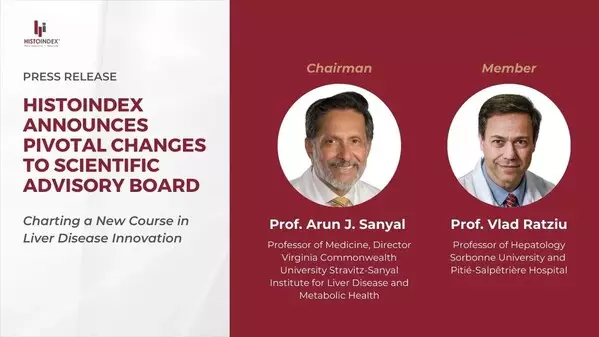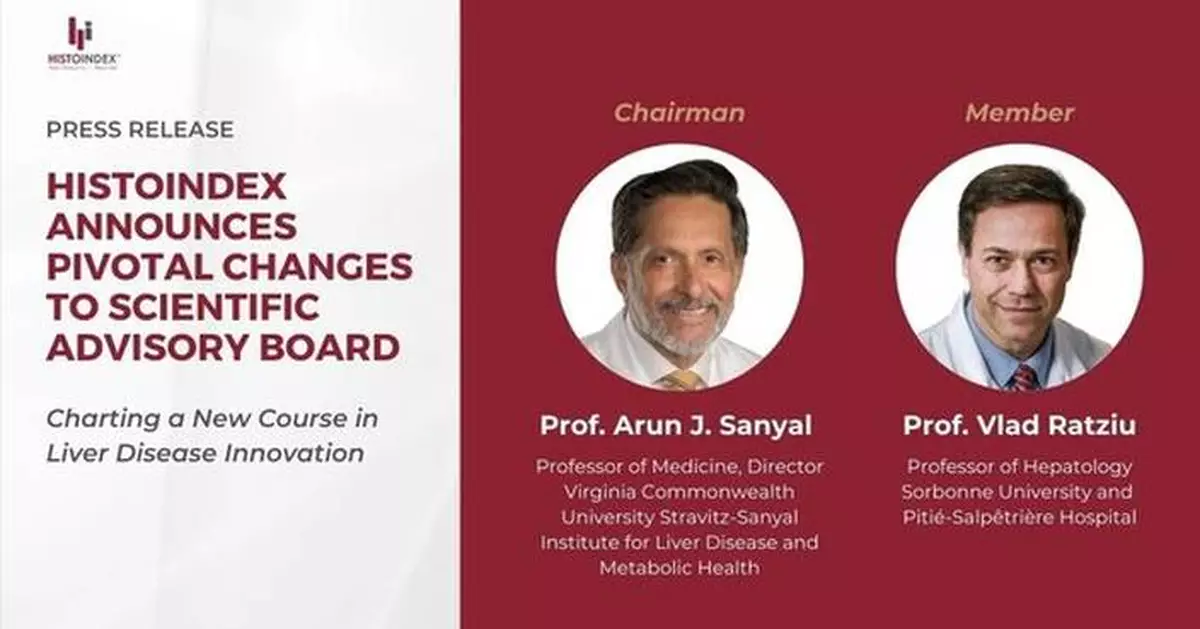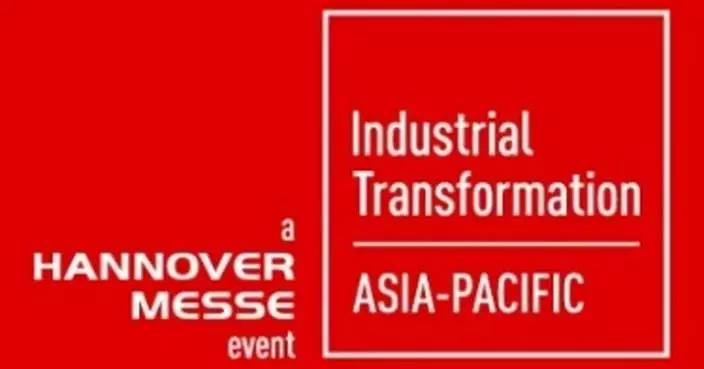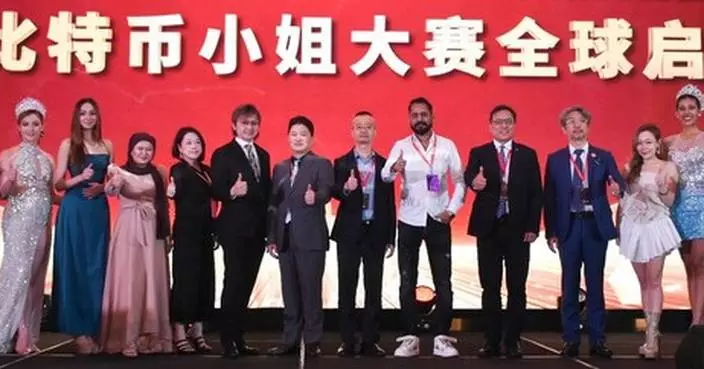SINGAPORE, July 1, 2024 /PRNewswire/ -- HistoIndex, a global leader in digital pathology solutions for the management of chronic liver disease, is pleased to announce changes to its Scientific Advisory Board (SAB). Established in 2017 under the leadership of the late Dr. Stephen A. Harrison, the SAB has played a crucial role in guiding HistoIndex's research and development efforts. Current members include Prof. Arun J. Sanyal, Prof. Quentin Anstee, Prof. Wei Lai, and Prof. Jacob George.
New SAB Appointments
Prof. Arun J. Sanyal, a professor of Medicine, Physiology, and Molecular Pathology at Virginia Commonwealth University (VCU) School of Medicine, has been appointed as the new Chairman of HistoIndex's SAB. Also serving as the Director of the Stravitz-Sanyal Institute for Liver Disease and Metabolic Health at VCU, Prof. Sanyal's leadership spans multiple prestigious roles as Chair of the NIH NASH Clinical Research Network, the NIMBLE consortium, and the Liver Forum. A continuous NIH grant recipient since 1995, Prof. Sanyal brings well over 500 publications in leading journals to the role, placing him in the top 0.1% of biomedical scientists globally. "I am honored to lead HistoIndex's Scientific Advisory Board," said Prof. Sanyal. "Our collective expertise will drive innovative solutions in chronic liver disease management, pushing the boundaries of scientific discovery to improve patient outcomes."
Prof. Vlad Ratziu, a professor of Hepatology at Sorbonne University and the Pitié-Salpêtrière Hospital in Paris, also joined the SAB. With over 400 publications and an H-index of 96, Prof. Ratziu is a prominent researcher in steatotic liver disease and hepatocellular carcinoma. He has played key roles in numerous MASH therapeutic trials and European research consortia, and is the incoming Editor-in-Chief of the Journal of Hepatology, a leading liver disease publication and the European Association for the Study of the Liver (EASL) flagship journal. "HistoIndex's technology has ushered in a new era in quantifying liver injury. The Company's commitment to innovation and collaboration among industry and academic leaders aligns perfectly with my scientific pursuits. I am thrilled to join the scientific board under Prof. Sanyal's leadership and contribute to innovative work benefiting MASH patients."
Remembering Dr. Stephen A. Harrison
As we embrace these new changes, we also pause to honor and remember the exceptional contributions of our late chairman, Dr. Stephen A. Harrison, a visionary leader in metabolic disease. His foresight to leverage AI for disease assessment in 2014 propelled HistoIndex's digital pathology solutions to the forefront of liver disease management. Dr. Gideon Ho, CEO of HistoIndex, reflected, "Stephen was more than our chairman; he was a true pioneer and mentor whose persistence and guidance brought our technology to maturation for enhanced patient care. His legacy will continue to inspire our work as we expand the applications of our platform technology to other diseases."
Innovative AI Tools
HistoIndex's pioneering AI-based image quantitative tools, qFibrosis and qSteatosis, have been incorporated in over 25 MASH clinical trials and demonstrated greater sensitivity in drug efficacy evaluations and patient stratification. Building on the same AI foundations, the Company developed qBallooning, which improved concordance among expert pathologists in ballooned hepatocyte evaluations. "Developing qBallooning is a significant step in standardizing and improving the evaluation of liver biopsies in MASH clinical research and practice," said Dr. Dean Tai, Chief Scientific Officer. "With these advancements and our strengthened SAB, HistoIndex is poised to accelerate liver disease drug development and diagnosis breakthroughs."
About MASLD and MASH
Metabolic dysfunction-associated steatotic liver disease (MASLD), previously known as non-alcoholic fatty liver disease (NAFLD), is a condition characterized by the buildup of fat in the liver in the absence of harmful alcohol intake. MASLD is closely associated with obesity, type 2 diabetes, and other metabolic disorders. It represents a spectrum of liver disorders ranging from simple steatosis (steatotic liver disease) to a more severe form known as metabolic dysfunction-associated steatohepatitis (MASH), formerly referred to as non-alcoholic steatohepatitis (NASH).
MASH is a progressive form of MASLD characterized by liver inflammation and damage, which can lead to fibrosis (scarring), cirrhosis, liver failure, and an increased risk of liver cancer. The presence of ballooned hepatocytes (enlarged and damaged liver cells) is a key feature distinguishing MASH from simple steatosis. Pathologist assessments of liver biopsy remains the gold standard for diagnosing and assessing the severity of MASH. Histological categorial scoring systems are often used as surrogate endpoints to evaluate drug efficacy in clinical trials. These endpoints are limited in capturing the complex and heterogeneous nature of the disease. As a result, there is a growing need for more accurate and reliable tools, such as AI-based digital pathology solutions, to improve the assessment of treatment response and disease severity in MASH.
About qFibrosis®, qSteatosis®, and qBallooning®
Current semi-quantitative histologic assessments of MASH are limited in precision for detecting subtle changes and introduce intra- and inter-observer variability. This impacts clinical trial recruitment and evaluation of drug efficacy. qFibrosis®, qSteatosis®, and qBallooning® are advanced tools that provide quantitative, continuous measures of key MASH features. Developed using the NASH-CRN scoring system as the reference standard, these tools quantitatively assess architectural parameters of collagen fibers, fat vacuoles, and hepatocytes to evaluate each histological feature optimally. As automated solutions, they offer enhanced reproducibility, precision, and sensitivity in determining disease severity and treatment responses, making them invaluable in clinical trials and research settings.
About HistoIndex
Founded in 2010, HistoIndex is a pioneer in stain-free, fully automated imaging solutions for visualizing and quantifying fibrosis in tissue biopsies. By combining cutting-edge biophotonic technology with AI-based analysis, HistoIndex provides innovative tools that transform research, expedite pharmaceutical drug development, and set new medical standards.
** The press release content is from PR Newswire. Bastille Post is not involved in its creation. **

HistoIndex Charts New Course in Liver Disease Innovation: Announces Pivotal Changes to Scientific Advisory Board










